-
PDF
- Split View
-
Views
-
Cite
Cite
Sheng-Miao Wu, Ting-Gui Wang, Xiao-Bo Dong, Broad reprocessed Balmer emission from warped accretion discs, Monthly Notices of the Royal Astronomical Society, Volume 389, Issue 1, September 2008, Pages 213–222, https://doi.org/10.1111/j.1365-2966.2008.13538.x
Close - Share Icon Share
Abstract
Double-peaked broad emission lines in active galactic nuclei are generally considered to be formed in an accretion disc. In this paper, we compute the profiles of reprocessing emission lines from a relativistic, warped accretion disc around a black hole in order to explore the possibility that certain asymmetries in the double-peaked emission-line profile which cannot be explained by a circular Keplerian disc may be induced by disc warping. The disc warping also provides a solution for the energy budget in the emission-line region because it increases the solid angle of the outer disc portion subtended to the inner portion of the disc. We adopted a parametrized disc geometry and a central point-like source of ionizing radiation to capture the main characteristics of the emission-line profile from such discs. We find that the ratio between the blue and red peaks of the line profiles becoming less than unity can be naturally predicted by a twisted warped disc, and a third peak can be produced in some cases. We show that disc warping can reproduce the main features of multipeaked line profiles of four active galactic nuclei from the Sloan Digital Sky Survey.
1 INTRODUCTION
A small fraction of active galactic nuclei (AGN) show double-peaked broad emission-line profiles (Eracleous & Halpern 1994; Eracleous & Halpern 2003; Strateva et al. 2003; Gezari, Halpern & Eracleous 2007). The possibility has been considered for a long time that at least some of these lines arise directly from the accretion discs assumed to feed the central supermassive black holes. The Hα profile observed in the spectrum of Arp 102B was modelled as arising in a relativistic disc by Chen & Halpern (1989) and Chen, Halpern & Filippenko (1989) in an attempt to explain the asymmetric double-peaked profiles. In these stationary circular relativistic disc models, Doppler boosting will make the blue peak of the profile higher than the red one. However, Miller & Peterson (1990) questioned the relativistic disc explanation for Arp 102B, by showing that at least at some epochs the profile asymmetry is reversed, with the red peak higher than the blue one in contrary to the prediction of homogeneous, circular relativistic disc models. This type of profile asymmetry has been observed in some other double-peaked sources (Strateva et al. 2003; Gezari et al. 2007). Thus, other scenarios for the profile asymmetry were considered later on, including various physically plausible processes in the accretion flow, such as spiral shocks, eccentric discs, bipolar outflows (Zheng, Sulentic & Binette 1990; Veilleux & Zheng 1991; Chakrabarti & Wiita 1993,1994; Eracleous et al. 1995; Storchi-Bergmann et al. 1997), as well as a binary black hole system (Begelman, Blandford & Rees 1980; Gaskell 1996; Zhang, Dultzin-Hacyan & Wang 2007b).
In addition to the line profile asymmetry, the energetic budget for the line emission region has not been solved so far for the disc model. It is demonstrated that the local viscous heating in the accretion disc is not sufficient to explain the observed Hα intensity (Chen et al. 1989; Eracleous et al. 1997), thus reprocessing of ultraviolet (UV)/X-ray continuum from the inner accretion disc is required. However, only a very small fraction of radiation from inner disc is expected to intercept the outer part of the disc in the case of a flat geometrically thin disc. Two types of processes have been proposed to increase the fraction of light incident on to the disc emission-line region. Chen et al. (1989) proposed that the inner part of the accretion disc is hot and becomes geometrically thick due to insufficient radiative cooling, and the X-ray emission from such an ion-supported torus is responsible for such energy input. However, double peak emitters do not always have a low accretion rate (Bian et al. 2007; Zhang, Dultzin-Hacyan & Wang 2007a). Furthermore, a detailed calculation of advection-dominated accretion flow (ADAF) models suggests that only a small portion of X-rays actually hit the emission-line portion of the disc (Cao & Wang 2006). On the other hand, Cao & Wang (2006) proposed that a slow-moving jet can scatter a substantial fraction of UV/X-ray light from the inner accretion disc back to the outer part of the disc. While this may be the likely case for radio-loud double-peaked emitters, the majority of double-peaked emitters are radio-quiet.
On the other hand, warped accretion discs are believed to exist in a variety of astrophysical systems, including X-ray binaries, T Tauri stars and AGN. The dynamics of warping accretion discs has been discussed by a number of authors (Papaloizou & Pringle 1983; Papaloizou & Lin 1995; Nelson & Papaloizou 1999; Ogilvie 1999; Nelson & Papaloizou 2000; Nayakshin 2005). Four main mechanisms for exciting/maintaining warping in accretion discs have been proposed, including: tidally induced warping by a companion in a binary system (Terquem & Bertout 1993; Larwood et al. 1996; Terquem & Bertout 1996), radiation driven or self-inducing warping (Maloney, Begelman & Pringle 1996; Pringle 1996; Maloney & Begelman 1997; Pringle 1997; Maloney, Begelman & Nowak 1998), magnetically driven disc warping (Lai 1999,2003; Pfeiffer & Lai 2004), and frame dragging driven warping (Bardeen & Petterson 1975; Kumar & Pringle 1985; Armitage & Natarajan 1999). As a result, the accretion disc in some AGN should be non-planar. Evidence for the existence of warped discs in AGN has been found by observations (Herrnstein et al. 2005; Caproni et al. 2007). A warped disc makes it possible for the radiation from the inner disc to reach the outer parts, enhancing the reprocessing emission lines. Thus, this warping can solve the long-standing energy-budget problem because the subtending angle of the outer disc portion to the inner part has been increased by the warp. It can also provide the asymmetry required for the variations of the emission lines. The effect of disc warping on iron line profiles treated relativistically have been made by Hartnoll & Blackman (2000) and Čadež et al. (2003). Bachev (1999) studied the broad-line Hβ profiles from a warped disc. Nevertheless, his treatment is non-relativistic. A relativistic treatment of warped disc on the Balmer lines which can be compared with observations is still not available in the literature.
In this paper, the broad Balmer emission due to reprocessing of the central high-energy radiation by a warped accretion disc is investigated. Our main purpose here is to describe the effect of disc warping on the line profiles. A parametrized disc model is adopted. In Section 2 we summarize the assumptions behind our model, and present the basic equations relevant to our problem. We present our results and the comparison with observations in Section 3, and conclusion and discussion in Section 4.
2 ASSUMPTIONS AND METHOD OF CALCULATION
In this paper, we will focus on how a warped disc affects the optical emission-line profiles, such as Hα and Hβ. A geometrically thin disc and a central point-like source of ionizing radiation around a black hole are assumed.
2.1 Geometrical considerations



The geometry used in this paper. The warped accretion disc is modelled as a collection of inclined rings, each defined by two Eulerian angles β, γ and the radial distance R. The normal to the equatorial plane is aligned with the Z direction. The direction to the observer is denoted by i that is the angle between the direction of line of sight and the Z-axis.









2.2 Photon motions in the background metric




 . The 4-momentum of a geodesic has components
. The 4-momentum of a geodesic has components 















 and Θμ(μ) =q2− (λ2+q2)μ2. The integral over r can be worked out with inverse Jacobian elliptic integrals (see e.g. Čadež et al. 1998; Wu & Wang 2007).
and Θμ(μ) =q2− (λ2+q2)μ2. The integral over r can be worked out with inverse Jacobian elliptic integrals (see e.g. Čadež et al. 1998; Wu & Wang 2007).Although our calculation is limited to Schwarzschild metric for photons travelling to infinity, for the radii (>100 rg) taken into account in this paper, the results are essentially the same for the Kerr black hole. On the other hand, for the light from inner part of the disc, a maximal Kerr metric is still used.
2.3 The observed line flux







2.4 Method of calculation
With all of the preparation described in the previous section, we now turn to how to calculate the line profiles numerically. We divide the disc into a number of arbitrarily narrow rings, and emission from each ring is calculated by considering its axisymmetry. We shall denote by ri the radius of each such emitting ring. For each ring there is a family of null geodesics along which radiation flows to a distant observer at polar angle ϑo from the disc's axis. As far as a specific emission line is concerned, for a given observed frequency νo the null geodesics in this family can be picked out if they exist. So, the weighted contribution of this ring to the line flux can be determined. The total observed flux can be obtained by summing over all emitting rings.
The main numerical procedures for computing the line profiles are as follows.
Specify the relevant disc system parameters: rin, rout, n1, n2, n3 and i, γ0.
The flux from the disc surface is integrated using Gauss–Legendre integration with an algorithm due to G. B. Rybicki (Press et al. 1992). The routine provides abscissas ri and weights ωi for the integration.
- For a given couple (ri, g) of a ring, the two constants of motion λ and q are determined if they exist. This is done in the following way. The value of λ is obtained by an alternate form of equation (27):the value of q is determined for solving photon trajectory equation (23). Then the contribution of this ring on the flux for a given frequency νo with respect to g is estimated. Varying g, this step is repeated, thus the flux contribution of this ring to all the possible frequency is obtained.35

- For each g, the integration over r of equation (32) can be replaced by a sum over all the emitting rings weighted by ωi:The Jacobian [∂(λ, q)/∂(r, g)] in the above formula was evaluated by a finite difference scheme. In the calculation the self-obscuration along the line of sight are also taken into account. This has been done as follows. The contribution of each element denoted by (ri, g) to the total line flux from the disc is calculated by equation (36) only in the case that there does not exist another element with cos θi > cos θ(ri, ϕi) along the ray path, and is zero in the opposite case. Here cos θi=h(ri, ϕi)/ri, cos θ(ri, ϕi) is calculated by36
 where the first equation describes the case with one turning point in θ component along the geodesic, ϕi can be calculated by equations (24) and (26) and P, KM, μ+ satisfy37
where the first equation describes the case with one turning point in θ component along the geodesic, ϕi can be calculated by equations (24) and (26) and P, KM, μ+ satisfy37

From the above formula, one determines the line flux at an arbitrary frequency νo from the disc. The observed line profile as a function of frequency νo is finally obtained in this way.
3 RESULTS
In the accretion disc model, the double-peaked emission lines are radiated from the disc region between around several hundred gravitational radii to more than 2000rg; here rg is the gravitational radius and the widths of double-peaked lines range from several thousand to nearly 40 000 km s−1 (Wang et al. 2005). In our model, all of the parameters of the warped disc are set to be free. The reasonable ranges are: disc radius from 100rg to 2000rg, n1 from 0 to 3π, n2 from 2 to 4, n2 from 0° to 30°. This model has the same number of free parameters as an eccentric disc model (Eracleous et al. 1995). In the range of frequency from 4.32 to 4.78 in units of 1014 Hz, 180 bins are used. Considering the broadening due to electron scattering or turbulence, all our results are smoothed by convolution with 3σ Gaussian (corresponding to 500 km s−1).
3.1 Line profiles from twisted warping discs
We extend the numerical code developed by Wu & Wang (2007) to deal with the warped discs. The images of the illuminated area and the Hα line profiles computed by our code for a steady-state twisted warping disc are shown in Figs 2 and 3. The disc zone is from Rin= 100rg to Rout= 1000rg, the other parameters are i= 30°, n1= 2.1π, n2= 3.0, n3= 10°, and i= 15°, n1= 2.1π, n2= 3.0, n3= 20°, respectively. The longitude of the observer γ0 with respect to the coordinate system of the disc from top left-hand side to bottom right-hand side varies from 0° to 330° with a step of 30°. The image of the illuminated portion of the disc has a shape similar to a one-armed disc. The image area of the disc being projected on the observer's sky from the far side of the disc due to a little angle between the tilt vector l(R, t) and the line of sight significantly larger than the near parts are indicated in Figs 2 and 3. In our code, one can specify an arbitrary grid for r or φ. In our calculations, all the images contain 400 × 360 pixels in this paper. The line profiles drawn in black are restricted to prograde disc models (relative to the normal to equatorial plane or black hole spin), the effects of a retrograde disc (identical to the prograde case with a reversed spin) on the line profiles should also be taken into account if the orientations of the AGN are isotropically distributed in space; those are drawn with dotted lines in the plots. The profiles from a prograde disc and its corresponding retrograde disc is close to but not exactly reflective symmetric about v= 0 because of relativistic boosting, the gravitational redshift and the asymmetry of the disc. Note also that there are triple-peaked profiles similar to those found by observations (Veilleux & Zheng 1991) and the obvious variation in the red/blue peak positions.
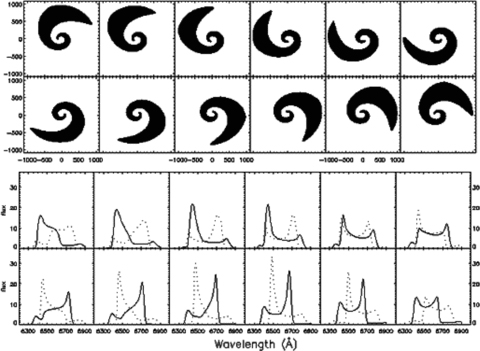
The images (upper panel) of the illuminated area of the disc and Hα line profiles (lower panel) computed by our code for twist warped disc case for i= 30°, n1= 2.1π, n2= 3.0, n3= 10°, the disc zone is from Rin= 100rg to Rout= 1000rg. The profiles from both prograde disc (black line) and retrograde disc (dotted line) are shown. The longitude of the observer γ0 with respect to the coordinate system of the disc takes steps of 30° from 0° to 330° (from top left-hand side to bottom right-hand side). All the results are smoothed by convolution with 3σ Gaussian (corresponding to 500 km s−1).
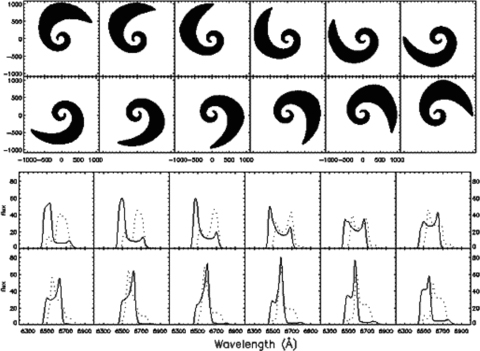
The influence of the phase amplitude (described by parameter n1) on the line profiles for n1= 0 (twist-free), π, 2π, 3π are shown in Fig. 4. The disc zone is from Rin= 100rg to Rout= 1200 rg, the other parameters are i= 30°, n2= 3.0, n3= 10°. The longitude of the observer γ0 with respect to the coordinate system of the disc varies from 0° to 300° with a step of 60° (from left- to right-hand side). For twist-free and low phase amplitude discs, the asymmetric as well as frequency-shifted single-peaked line profiles expected in most cases are produced. For n1 > 2π, there is a fairly large possibility for a triple-peaked line profile. The influence of the phase amplitude on the line profiles is remarkable.
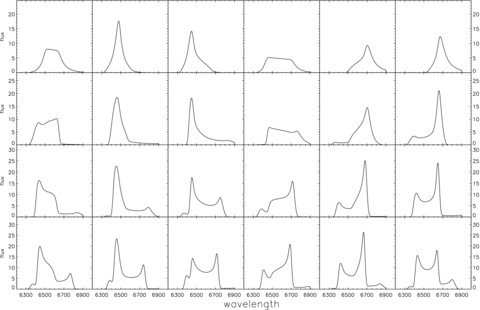
Comparison of the Hα line profiles generated by our code for warped disc cases with different phase amplitude (described by parameter n1), n1= 0, π, 2π, 3π (from top to bottom panels). The other parameters are: i= 30°, n2= 3.0, n3= 10°, Rin= 100rg and Rout= 1200rg. The longitude of the observer γ0 with respect to the coordinate system of the disc varies from 0° to 300° with a step of 60° (from left- to right-hand side).
The fraction of light incident to the disc from the inner region is a function of n1, n3. We calculate the fraction received by a warped disc, the results are shown in Fig. 5. The fraction reaches 27.3 per cent for a twisted warp disc n1= 2.0π, n2= 3.0, n3= 20°.
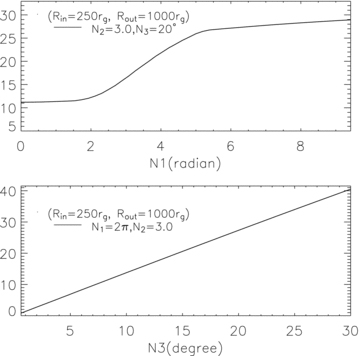
The fraction of light incident to the disc from the inner region as a function of n1 or n3. The disc zone is from Rin= 250rg to Rout= 1000rg.
3.2 Comparison with the observations
As the first step, our main purpose in this paper is to demonstrate the effect of disc warping on the line profiles, while the detailed fitting of the observational data will be presented in a future paper. From the sample of AGN with double-peaked Balmer lines drawn from the Sloan Digital Sky Survey (SDSS) spectroscopic data set (Shan et al., in preparation), we pick up four sources with peculiar profiles: SDSS J084205.57+075925.5, SDSS J232721.96+152437.3, SDSS J094321.97+042412.0, SDSS J093653.84+533126.8. Two of them have explicit triple-peaked profiles, the others show a net shift of the emission lines to the red. These features are hard to interpret via a homogeneous, circular relativistic disc model. The SDSS spectrum of one object (SDSS J232721.96+152437.3) is dominated by starlight from the host galaxy; we subtract the starlight and the nuclear continuum with the method as described in detail in Zhou et al. (2006). The other three spectra have little starlight contamination, the nuclear continuum and the Fe ii emission multiplets are modelled as described in detail in Dong et al. (2008). The Fe ii emission lines are apparent in J0936+5331.
The observed broad line spectrum of sources SDSS J084205.57+075925.5, SDSS J232721.96+152437.3 both have a third peak. The line profiles (grey line) calculated by our code compared with observations are shown in Figs 6 and 7. The disc zone is from Rin= 250rg to Rout= 1000 rg, and n2= 3.0 for a prograde disc case. The other parameters are: i= 13°, n1= 3.0π, n3= 28°, γ0= 95° for SDSS J084205.57+075925.5, i= 10°, n1= 2.6π, n3= 22°, γ0= 88° for SDSS J232721.96+152437.3, respectively. We have taken the approach that the disc-like component should be fitted by eye to as much of the peaks' match as possible. While our model does not reproduce the extended wing, the peak positions and heights are reasonably in agreement with the observed profiles.
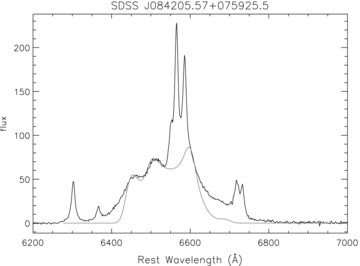
Comparison of the Hα line profiles computed by our code (grey line) with the observation of SDSS J084205.57+075925.5. The parameters are: i= 13°, n1= 3.0π, n2= 3.0, n3= 28°, γ0= 95°, the disc zone is from Rin= 250rg to Rout= 1000rg for a prograde disc.
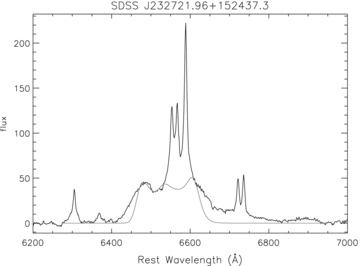
Comparison of the Hα line profiles computed by our code (grey line) with the observation of SDSS J232721.96+152437.3. The parameters are: i= 10°, n1= 2.6π, n2= 3.0, n3= 22°, γ0= 88°, the disc zone is from Rin= 250rg to Rout= 1000 rg for a prograde disc.
A retrograde disc is needed to match the line profiles with the observations for SDSS J094321.97+042412.0, J093653.84+533126.8. Fig. 8 shows the comparison between the line profiles and the observed profile for SDSS J094321.97+042412.0 with i= 17°, n1= 2.1π, n3= 24°, γ0= 202°. And the parameters in Fig. 9 for SDSS J093653.84+533126.8 are: i= 8°, n1= 2.1π, n3= 6°, γ0= 117°. The disc zone is still taken from Rin= 250rg to Rout= 1000 rg, and n2= 3.0. We see that the overall match except that in two wings between the line profiles and the observations is good qualitatively. The deviation in the two wings may, mostly due to the central point-like source adopted, diminish the contribution from the relatively inner part of the reprocessing region.
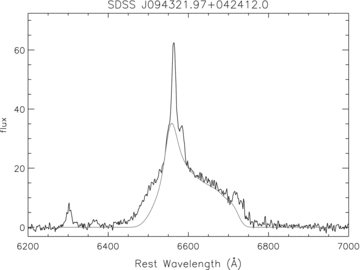
Comparison of the Hα line profiles computed by our code (grey line) with the observation of SDSS J094321.97+042412.0. The parameters are: i= 17°, n1= 2.1π, n2= 3.0, n3= 24°, γ0= 202°, the disc zone is from Rin= 250rg to Rout= 1000rg for a retrograde disc.
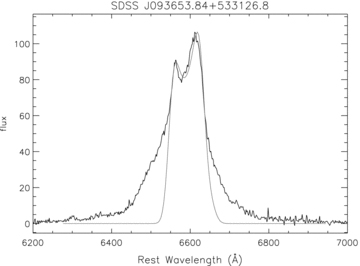
Comparison of the Hα line profiles computed by our code (grey line) with the observation of SDSS J093653.84+533126.8. The parameters are: i= 8°, n1= 2.1π, n2= 3.0, n3= 6°, γ0= 117°, the disc zone is from Rin= 250rg to Rout= 1000rg for a retrograde disc.
The line profiles with respect to different longitude of the observer are corresponding to the observations in different times in reality. Thus the variation of the line profiles with respect to different longitude can be compared with successive observations. The images of the illuminated area and the Hα line profiles for sources SDSS J232721.96+152437.3, SDSS J093653.84+533126.8 are shown in Figs 10 and 11. In Fig. 10 the parameters of the disc are: i= 10°, n1= 2.6π, n2= 3.0, n3= 22°, Rin= 250rg, Rout= 1000 rg for a prograde disc. The longitude of the observer γ0 from top left-hand side to bottom right-hand side takes steps of 10° from 30° to 140°. A retrograde disc with i= 8°, n1= 2.1π, n2= 3.0, n3= 6°, Rin= 250rg and Rout= 1000rg, the longitude of the observer γ0 from top left-hand side to bottom right-hand side takes steps of 10° from 50° to 160° (shown in Fig. 11). Long-term monitoring of these sources should provide critical tests for the disc warping scenarios.
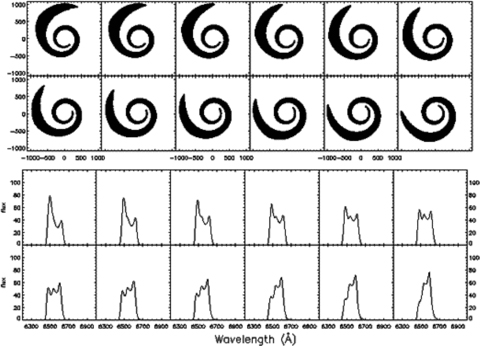
The images (upper panel) of the illuminated area of the disc and Hα line profiles (lower panel) computed by our code for twist warped disc cases for i= 10°, n1= 2.6π, n2= 3.0, n3= 22°, the disc zone is from Rin= 250rg to Rout= 1000rg for a prograde disc. The longitude of the observer γ0 with respect to the coordinate system of the disc from top left-hand side to bottom right-hand side takes steps of 10° from 30° to 140°. The variation of the line profiles with respect to different longitude corresponds to different observation time and can be compared with the future observations of source SDSS J232721.96+152437.3.
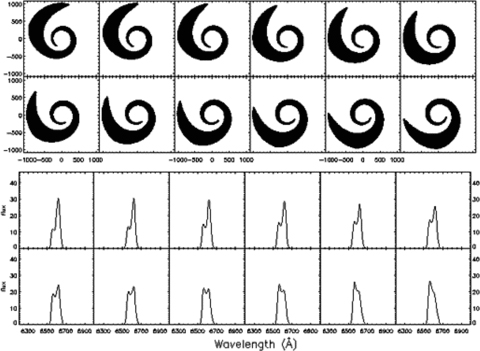
The images (upper panel) of the illuminated area of the disc and Hα line profiles (lower panel) computed by our code for twist warped disc cases for i= 8°, n1= 2.1π, n2= 3.0, n3= 6°, the disc zone is from Rin= 250rg to Rout= 1000rg for a retrograde disc. The longitude of the observer γ0 with respect to the coordinate system of the disc from top left-hand side to bottom right-hand side takes steps of 10° from 50° to 160°. The variation of the line profiles with respect to different longitude can be compared with successive observation of source SDSS J093653.84+533126.8.
4 SUMMARY
We compute the reprocessing emission-line profiles from a warped relativistic accretion disc around a central black hole by including all relativistic effects. A parametrized disc model is used to obtain an insight into the impact of disc warping on the double-peaked Balmer emission-line profiles. For simplicity, we assumed that the disc is illuminated by a point-like central source, which is a good approximation, the line emissivity is proportional to the continuum light intercepted by the accretion disc, and line emission is isotropic. We find the following.
For twist-free or low phase amplitude (described by n1) warped disc, the asymmetrical and frequency-shifted single-peaked line profiles as expected are produced in most cases. The rarity of such sources suggests that a warping disc is usually twisted.
The flux ratio of the blue peak to red one becoming less than unity can be predicted by a twisted warp disc with high phase amplitude. The phase amplitude has a significant influence on the line profiles.
A third peak and the variation in blue/red peak position which have been found by observations (Veilleux & Zheng 1991; Strateva et al. 2003) are produced in our model.
The influence from retrograde disc on line profiles has a inverse effect compared with a prograde one.
The fraction of the radiation incident to the outer disc from the inner part can be enhanced by disc warping. The results are shown in Fig. 5.
We showed that warped disc model is flexible enough to reproduce a variety of line profiles including triplet-peaked line profiles, or double-peaked profiles with additional plateaus in the line wing as observed in the SDSS spectra of some AGN, while the models have the same number of free parameters as eccentric disc models. While we leave the detailed fit to a future paper, the essential characteristics in the line profiles is in good agreement with observed line profiles. Future monitoring of line profile variability in these triplet sources can provide a critical test of the warped disc model.
This definition of φ differs by π/2 from that of Pringle (1996).
We would like to thank the anonymous referee for his/her helpful suggestions and comments which helped to improve and clarify our paper.
REFERENCES




